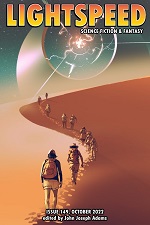“Primordial Soup and Salad” by Gene Doucette
“The Tragic Fate of the City of O-Rashad” by P H Lee
“The Conflagration at the Museum of You” by Adam-Troy Castro
“The Daydreamer by Proxy” by Dexter Palmer (reprint, not reviewed)
“The Three Books and What They Tell” by Alexandra Manglis
“Apolépisi: A De-Scaling” by Suzan Palumbo
“Three Tales from the Blue Library” by Sofia Samatar (reprint, not reviewed)
“The Dirty Golden Yellow House” by Debbie Urbanski
Reviewed by Victoria Silverwolf
An even balance between original works of science fiction and fantasy appears in this issue, with one novelette, one short story, and one piece of flash fiction from each genre.
“Primordial Soup and Salad” by Gene Doucette takes place aboard a starship that will seem very familiar to anyone who has ever seen an episode of Star Trek. The food replicators break down. The organic substance from which edibles are created has evolved into a mass of living organisms that fight to survive. The struggle to save the crew from starvation leads to an unexpected fate.
The mood is one of comedy, which somehow manages to be both very light and very dark. While not quite a spoof of the classic television series mentioned above, the setting resembles the Enterprise so strongly that it is impossible to escape the comparison. This, combined with a premise that becomes more implausible as it continues, makes it hard to suspend one’s disbelief. The story is written in a very smooth, readable style, and many will find it amusing enough to be worth a look.
“The Tragic Fate of the City of O-Rashad” by P H Lee is a very short piece, written in a Biblical style, about a magnificent community that, in its pride, fails to see to its defense. The text implies that spending either too little or too much on the military will lead to destruction. Even if it is not entirely clear what point the author is making, the work is an interesting prose poem.
The reader is addressed directly in “The Conflagration at the Museum of You” by Adam-Troy Castro. It seems that aliens have taken a great interest in you, recording all the incidents in your life and studying them obsessively. An outcast among the aliens, hating you for the way others of its kind are fascinated by you, takes drastic action.
This work is something of a tour de force in the way it manages to create the feeling of an entire life in all its details. The aliens are said to be almost unimaginably different from people, so much of the text describes their actions and feelings in what the author admits are weak analogies with human ones. This tends to lessen the story’s enjoyable sense of otherness, which is one of its most appealing aspects.
“The Three Books and What They Tell” by Alexandra Manglis is a tiny bit of surrealism about a trio of bizarre volumes, their contents, and what happens to those who enter them. This little jewel of a work is an effective exercise in sensory description, even if it is hardly a story at all.
The characters in “Apolépisi: A De-Scaling” by Suzan Palumbo are merfolk. The narrator’s mate is losing her scales, a sign that she will slowly change into a human being and be forced to dwell on land. The simple plot of this fairly short story can be interpreted as a metaphor for losing a loved one. Although there is not much to it other than the basic premise, the author’s descriptions of the underwater world make for a vivid reading experience.
“The Dirty Golden Yellow House” by Debbie Urbanski is a difficult story to summarize. A woman who is repeatedly raped by her husband arranges for a woman with mystic powers to kill him, but at a terrible price.
This very brief synopsis is extremely misleading. It suggests that the work is an ordinary horror story, which is not at all the case. The author uses postmodern, self-referential techniques to an extreme degree.
The nameless narrator is a writer of fiction, telling this story as if it is both a real account (with names changed) and a completely imaginary tale. Supernatural events happen to the narrator, and these can be interpreted as real events or symbolic metaphors. Some parts of the text are non-fiction discussions of marital rape, and the narrator tells readers that they are free to skip these sections. The narrator even quotes reviews of other writings.
One technique stands out, and is worthy of consideration. The word rape occurs frequently in the text, but it always appears as r—. Whether this is a grimly satiric way of pointing out that the topic of sexual violence is often thought of as unworthy of open discussion, or if the author has some other intent in mind, remains unclear.
This is a complex, difficult, multilayered work on an important theme. It has a powerful emotional impact, and sensitive readers may find it overly disturbing. Whether the structure detracts from the story’s strength is likely to be a matter of opinion.
Victoria Silverwolf thinks the final story is one of the few she has read for which a content warning might be appropriate.
 Lightspeed
Lightspeed